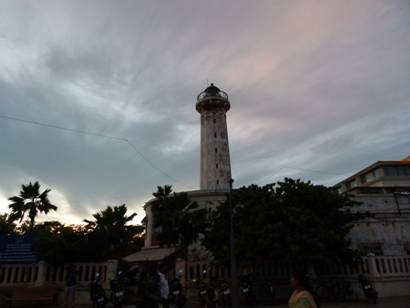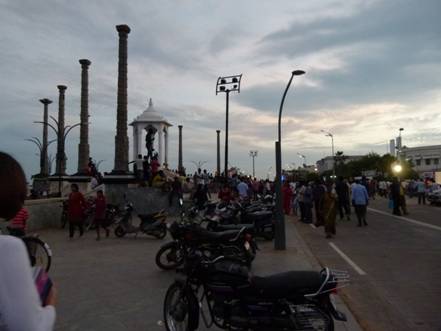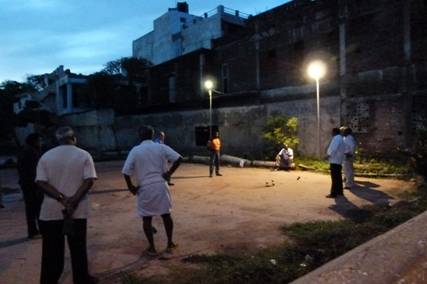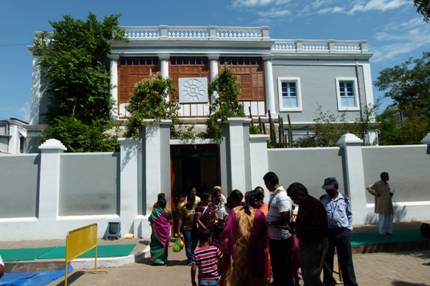Pondicherry (Puducherry)
Pondicherry was once a Roman trading post. The local museum has several Roman Amphora, used for wine and oil as well as Roman gold jewellery and coins, found in local archaeological sites.

Like other areas of southern India we visited it became a European trading station after the Portuguese discovered the sea route to India. But in this case it changed hands a bewildering number of times.
The British East India Company was established by wealthy merchants and aristocrats interested in trade with the East Indies and received its Royal Charter and a 15 year monopoly on this trade with Britain from Elizabeth I in 1600.
Like the French the Dutch and the Danish East India Companies their principal goal was profitable trade with the corresponding Indian business interests. Trade is a two way street. There has to be someone to take your goods in return. For two centuries the various European East India Companies traded in their respective wares, happily making money for their investors, except when European politics, wars between the home nations, muddied the relationships between them; or when their Indian trading and treaty partners were victims of a coup or became involved in military conflicts locally. The Companies had little interest in ruling territory as such; or in converting souls as had the Portuguese.
Generally treaties were signed with local rulers to establish a secure base for trading. The Europeans wanted the locals to stop any activity that interfered with the efficient conduct of trade or their treaties and agreements.
The French the Dutch and the Danish East India Companies generally kept out of local politics but over the couple of centuries the British East India Company progressively built up over 70 regiments of Sepoys – local troops - that they used to enforce law and order across the sub-continent.
They also ruthlessly slapped-down any uppity prince or Maharajah who decided to go on the warpath against a neighbour; as they had been wont to do over the past thousand or so years.
First, the French East India Company set up a trading centre at Pondicherry in 1674; which then grew to become the principal French trading base in India.
The Dutch then captured Pondicherry in 1693 but returned it to France by the Treaty of Ryswick in 1699.
In 1761, the British East India Company captured Pondicherry but returned it to the French in 1763 under the Treaty of Paris. The British Company then took it again in 1793 and returned it yet again in 1814.
In 1857 troops of the British East India Company mutinied, resulting in the temporary loss of law and order in the country. Local rulers took the opportunity to settle long term rivalries with military excursions and widespread rioting and looting took place in major cities.
The rebellion was put-down with such force by the remaining loyal troops of the British East India Company, reinforced by British soldiers from the Crimea, that the British Parliament nationalised the Company; partly in disgust at the slaughter and partly because of the devastation to British interests.
The Government of India Act 1858 passed all Company administrative powers, and its armed forces, to the Crown. Queen Victoria became Empress of India; a country she would never see.
As a consequence of this Act the French and Portuguese settlements of Goa and Pondicherry (encompassing Pondicherry, Mahe, Yanam, Karaikal and Chandernagar) were excised from British Imperial India. They effectively became separate countries or colonies.
When India gained Independence in 1947 negotiations began for the surrender of France's Indian possessions.
This took many years. Important stages were the surrender of bureaucratic control in 1954; leading to full legal union in 1963.

The Independence - or perhaps Dependence - Memorial featuring Gandhi in his Dhoti
So it was not necessary for India to use military force to annex the French territory; as they had against the more reluctant Portuguese in Goa.
As a result there is still a good deal of French cultural interest; with French still spoken as a major local language; and locals playing boules along the seafront.

Our hotel was initially full of school boys on an excursion. Otherwise it was very good.
Apart from the traffic, the town is relatively nice with an extensive, rather pretty, French quarter featuring lots of boutique shops for the tourists commingled with the several ashrams.
Eat, pray, love. We soon saw a blonde women communing with her guru down by the sea.
Even our driver seemed oracular. But this was because he had very little English and didn't understand much of what we asked him. He was like a random statement generator.
The ashram business is booming. We went into one to see both Europeans and Indians in contemplation.

I much prefer a beautiful church and I reckon that if you need a supernatural being; or personal spirit; or just somewhere to sit; the Christians have a much better formula. Churches, monasteries and convents and even some mosques, generally have a more convincing sense of quiet, serenity and beauty than an Ashram.
You can even feel this effect at 'The Cloisters' in New York and that is simply a museum. Or try the real thing - Evensong in Durham Cathedral at sunset - beautiful. But then, I'm culturally prejudiced - and what's with tearing all those flowers apart?
Again we are in no-map land. Even the concierge who gave us a map couldn't show us where the hotel was on it. I found it first - 'oh yes' he said.
Most people have no concept of a map.
I asked the staff in a Café Coffee Day coffee shop who spoke passable English to show me where on a map the shop was - incomprehension. Then I tried where we are now? - was I mad you are here! Yes but where is here on this map? - Incomprehension. Then they tried where do you want to go? So I pointed out a spot on the map - incomprehension. Was I mad? The map was here. It would have been a great Goon Show script.
Even drivers we hired city to city, door to door, had no map and found the destination by a process of stop and ask a local cab driver. The street address was useless to them.
